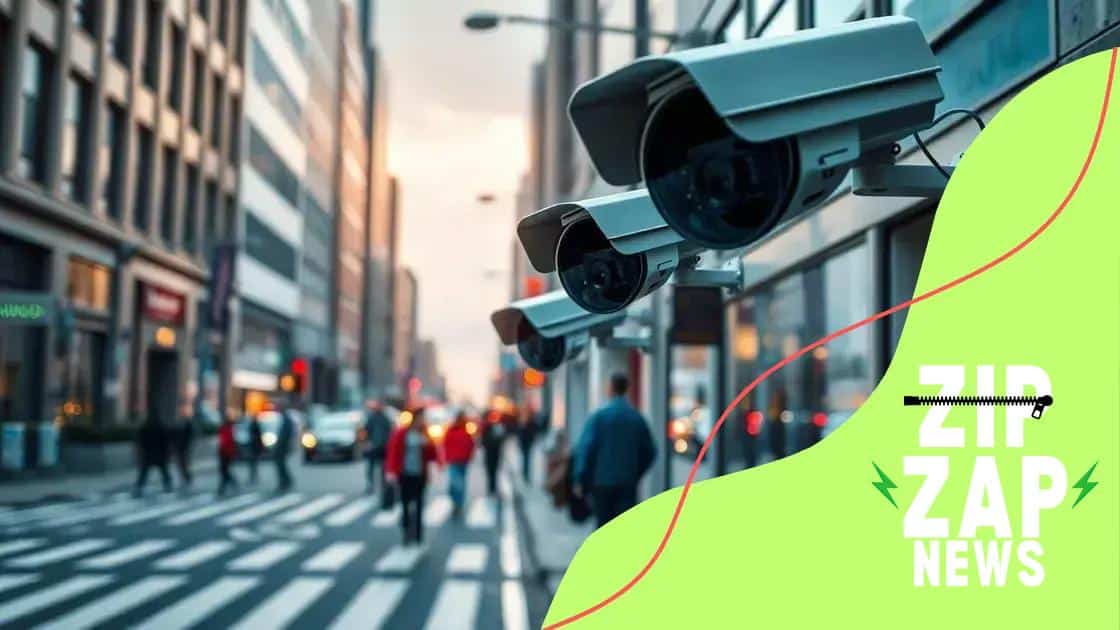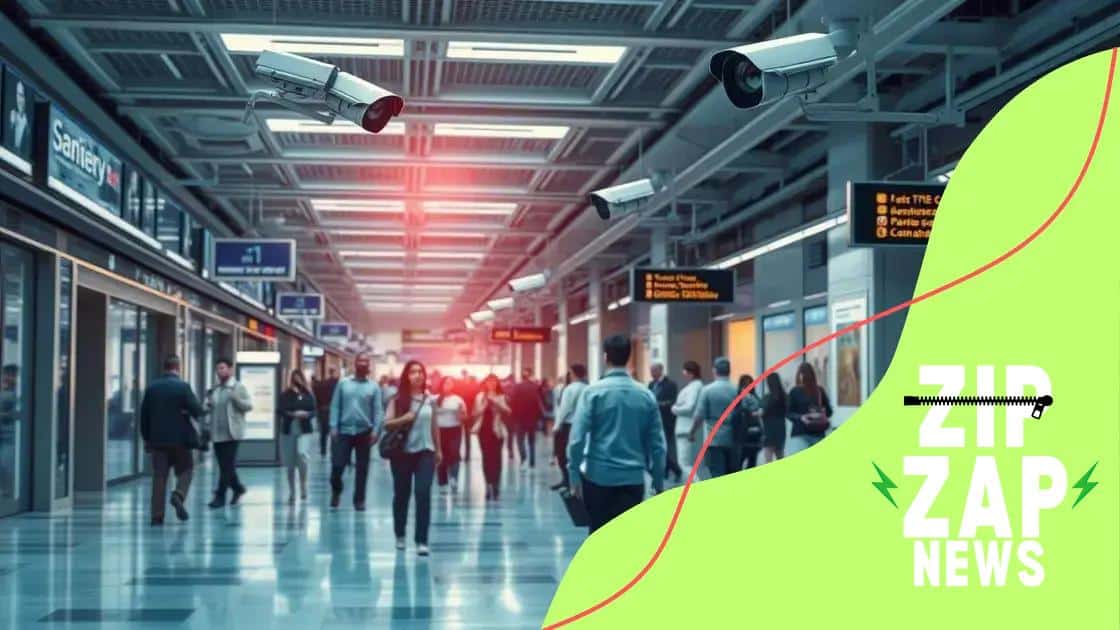The role of facial recognition in enhancing public safety

The role of facial recognition in enhancing public safety includes improving crime detection, accelerating emergency responses, and personalizing security measures, while addressing important privacy concerns and ethical implications.
The role of facial recognition in enhancing public safety has become a hot topic in recent years. With advancements in technology, you may wonder how these systems can actually improve security measures in our daily lives. Let’s dive into this fascinating subject.
Understanding facial recognition technology
Understanding facial recognition technology is essential in today’s digital landscape. This technology uses algorithms to identify and verify individuals’ faces in images or videos. By analyzing facial features and comparing them to databases, systems can determine a person’s identity with impressive accuracy.
How Facial Recognition Works
The process begins with capturing an image, which can be a live feed or a static photo. The system then detects faces and extracts key features, such as the distance between the eyes, nose width, and jawline shape. These features create a unique facial signature.
Key Components of Facial Recognition
- Face Detection: Identifying the presence of a face within an image.
- Feature Extraction: Analyzing and marking the distinctive characteristics of a face.
- Face Matching: Comparing the extracted features against a database.
- Verification vs. Identification: Verifying a person’s identity versus identifying an unknown individual.
Implementation often requires a robust database, containing images of individuals for accurate matching. As a result, these systems rely heavily on machine learning to improve their accuracy over time.
As facial recognition technology continues to evolve, it raises discussions about its role in enhancing public safety. The balance between security and privacy remains a pivotal concern. In many regions, laws are evolving to address these issues, striving to create frameworks that allow the use of this technology without infringing on individual rights.
Some applications include security systems in airports, surveillance in public spaces, and even personal device unlock features. With its diverse uses, understanding this technology is crucial for engaging in informed debates about its implications.
Benefits of facial recognition for public safety
The benefits of facial recognition for public safety are becoming more apparent as cities adopt this technology. By enhancing security measures, communities can experience a safer environment. This technology enables faster responses from law enforcement and aids in crime prevention.
Enhancing Crime Detection
Facial recognition can assist police in identifying suspects quickly. When a crime occurs, authorities can analyze surveillance footage with this technology. By matching faces with existing databases, they can locate perpetrators efficiently.
Improving Emergency Response
In emergency situations, every second counts. Facial recognition technology helps pinpoint individuals in distress or those on watchlists. This support allows emergency responders to act swiftly, potentially saving lives.
- Quick Identification: Bystanders can be identified rapidly.
- Access Control: Unauthorized individuals can be flagged instantly.
- Boosting Security in Public Events: Large gatherings can be monitored effectively.
Moreover, this technology can serve as a powerful deterrent. Knowing that facial recognition systems are in place can discourage criminal behavior. As a result, public spaces, such as parks and malls, can feel safer for everyone.
It also aids in locating missing persons and enhances overall safety protocols. With databases constantly updated, authorities can access valuable information that could prevent crime.
The integration of facial recognition technology in public safety initiatives can streamline operations and improve collaboration among agencies. Ultimately, these benefits highlight the potential of technological advancements in making communities safer.
Privacy concerns and ethical implications

Privacy concerns and ethical implications are critical discussions surrounding facial recognition technology. As this technology becomes more common, many people worry about how their personal data is handled. It’s vital to examine these issues to understand its impact on society.
Data Privacy Risks
The collection of facial images raises significant privacy concerns. Individuals may not be aware that their faces are being scanned and stored. This lack of transparency can lead to a feeling of being constantly watched.
Misuse of Technology
There’s also the risk of misuse. For instance, unauthorized access to facial recognition databases can lead to identity theft. Additionally, the technology might be used for discriminatory practices, especially against marginalized groups. It’s essential to address these potential abuses to ensure fair usage.
- Surveillance Overreach: The possibility of excessive surveillance can deter people from freely expressing themselves.
- Bias in Algorithms: Facial recognition systems may misidentify individuals, particularly those with darker skin tones.
- Consent Issues: Many users are unaware of how their facial data is being used or shared.
Legislation is evolving to address these privacy concerns, but many argue that current laws may not be sufficient. Advocates for stronger regulations emphasize the need for explicit consent before facial recognition technology is used. They stress the importance of protecting individuals’ rights in the digital age.
By placing ethical considerations front and center, we can work towards a future where facial recognition technology is used responsibly and with respect for individual privacy. Ongoing discussions about its implementation are crucial as societies navigate the trade-offs between safety and personal freedoms.
Real-world applications of facial recognition
The real-world applications of facial recognition extend across various industries, showcasing its versatility and effectiveness. This technology is not limited to law enforcement; it is being utilized in numerous sectors to improve security and streamline processes.
Security and Surveillance
One of the most common applications is in security systems. Businesses and public areas use facial recognition to monitor individuals who enter their properties. Surveillance cameras equipped with this technology can identify faces in real-time, enhancing security measures against potential threats.
Retail Industry
In retail, companies use facial recognition to personalize the shopping experience. By recognizing customers upon entering stores, retailers can offer tailored promotions and improve customer service. This technology also assists in tracking customer behavior, helping retailers understand shopping patterns.
- Access Control: Facial recognition systems manage access to secure areas in workplaces.
- Event Management: Large events use facial recognition for quick check-ins.
- Smartphone Unlocking: Many smartphones utilize this technology to unlock devices efficiently.
Moreover, the healthcare industry benefits from facial recognition by improving patient identification and safety. Accurate identification reduces errors and enhances overall patient care. Hospitals use it to limit unauthorized access to sensitive areas.
Facial recognition also plays a role in travel and transportation. Airports use this technology to speed up the check-in process and verify identities at security checkpoints. By streamlining operations, travel becomes more efficient for both passengers and airport staff.
The continued advancement of facial recognition technology indicates that its applications will expand further. As systems become more sophisticated, we can expect ongoing integration into everyday life, enhancing security and user experiences across multiple platforms.
Future trends in public safety technology
The future trends in public safety technology suggest an evolving landscape where innovation plays a crucial role in enhancing security measures. As technology advances, it is vital to keep an eye on how these developments can create safer environments for communities.
Integration of AI with Security Systems
Artificial intelligence (AI) is expected to significantly improve public safety technologies. By integrating AI with facial recognition systems, security can become more proactive rather than reactive. This integration will help law enforcement anticipate potential threats through predictive analytics.
Enhanced Data Sharing Between Agencies
Collaboration among different law enforcement agencies will likely increase. With enhanced data sharing, officers can access a wider range of information about suspects and incidents. This connectivity can lead to faster response times and more efficient operations.
- Use of Drones: Drones equipped with cameras can monitor large areas quickly, providing real-time data to authorities.
- Smart City Technologies: Integration of sensors and cameras to gather data about public spaces will help predict emergencies.
- Body Cameras: Enhanced body cameras will provide clearer recordings and automatic uploads to databases.
Another upcoming trend is the use of biometric data beyond just face recognition. Voice and gait recognition might also play a role in identifying individuals accurately in various scenarios. As false positives remain a concern, such systems aim to improve accuracy.
The rise of mobile applications allows citizens to report suspicious activities instantly. These apps can also alert users about emergencies in their vicinity, promoting community involvement in public safety efforts.
Overall, the future of public safety technology looks promising, as advancements aim to create safer environments with innovative solutions that foster trust and collaboration between the community and law enforcement.
FAQ – Frequently Asked Questions about Facial Recognition Technology in Public Safety
What are the main uses of facial recognition technology?
Facial recognition technology is used in security systems, retail for customer personalization, and in airports for identity verification.
How can facial recognition enhance public safety?
It enhances public safety by quickly identifying suspects, improving response times, and deterring potential criminal activities.
What are the privacy concerns associated with facial recognition?
Privacy concerns include unauthorized data collection, potential misuse of information, and lack of consent from individuals whose faces are scanned.
What future trends can we expect in public safety technology?
Future trends include better integration with AI, enhanced data sharing among agencies, and the use of biometrics beyond just facial recognition.





